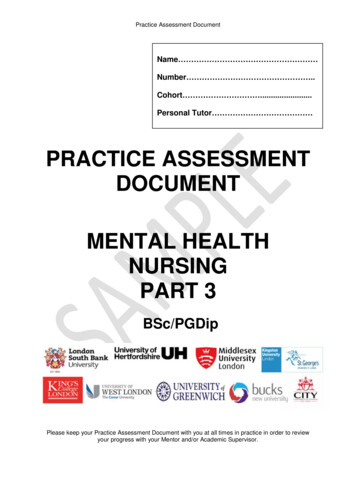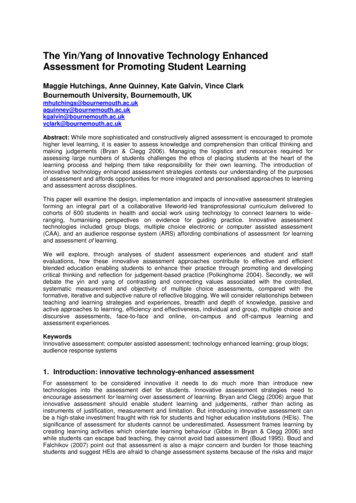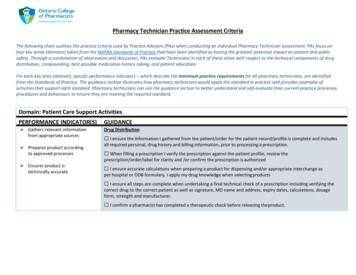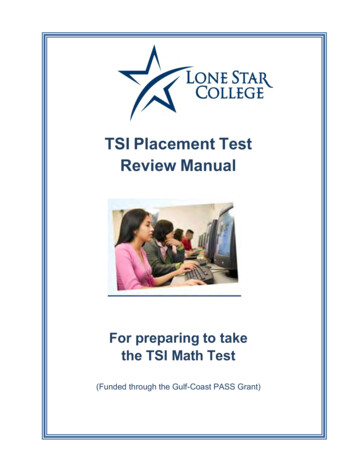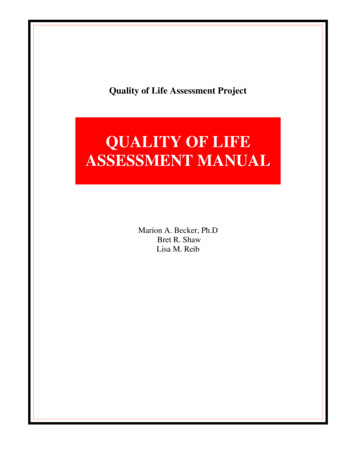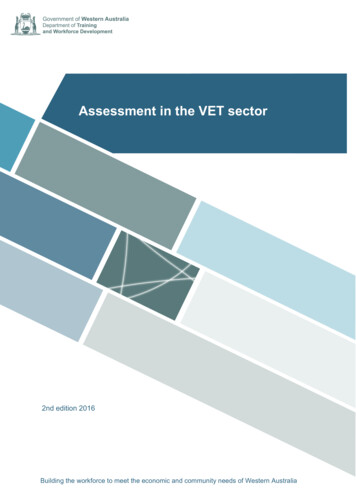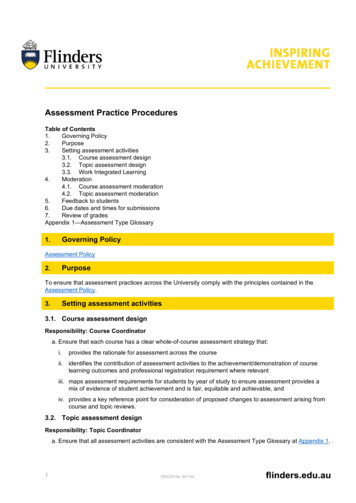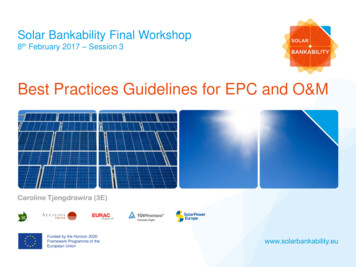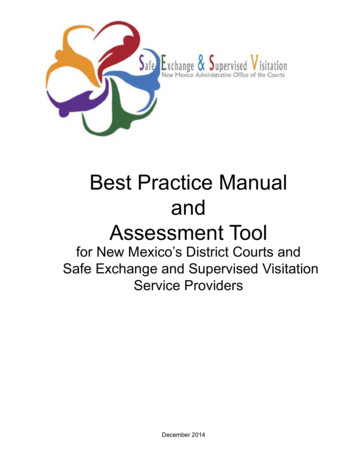
Transcription
Best Practice ManualandAssessment Toolfor New Mexico’s District Courts andSafe Exchange and Supervised VisitationService ProvidersDecember 2014
Table of ContentsPart 1: Introduction and Oveview.5I. Purpose of This Manual.5II. Program Overview.5A. Program Purpose and Goals.6B. SESV Services.8III. Manual Organization .9Part 2: Best Practices.11I. Court Specific Elements.11Element #1: Referral Criteria.11Element #2: Court Orders.11Element #3: Judicial Education.13II. Provider Specific Elements.14A. Safety and Security.14Element #4: Staffing.15Element #5: Premises.17Element #6: Critical Incidents.18Element #7: High Risk Cases.19B. Services.20Element #8: Intake and Orientation.21Element #9: Risk Assessment.23Element #10: Case Staffing and Review by Providers.24Element #11: Observation Notes.25Element #12: Staff Training and Supervision.27Element #13: Visit and Exchange Management.29Element #14: Collaboration and Coordination.31C. Principles of Practice.31Element #15: Confidentiality.32Element #16: Neutrality and Conflict of Interest.33Element #17: Factuality.36Element #18: Grievances . . .37III. Court-Provider Elements.38Element #19: Reporting to Court.39Element #20: Communication Procedures.41Element #21: Compliance Issues.41IV. AOC Elements.42Element #22: Contractual Obligations.42Element #23: Relationship with District Court.43Part 3: AOC Program Assessment.44I. Description of Program Assessment.44II. Description of the Program Assessment Tool.44
Appendices.45I. Relevant Laws, Regulations and Standards.46A. New Mexico State Law.46B. New Mexico Supreme Court Rules.56C. New Mexico Court Standards for Safe Exchange and Supervised Visitation.59II. Sample Forms.70A. Routine Status Report.70B. Special Report.71C. Court Order.72III. References.75IV. Assessment Tool.77
Part 1: Introduction and OverviewI. Purpose of This ManualThis manual is intended to provide guidance in establishing and/or improving Safe Exchangeand Supervised Visitation (SESV) services. It offers direction about implementing SESVservices and best practices for providing services to families referred to the SESV program.Additionally, the manual was developed to help create a shared understanding of the SESVprogram and its essential components. This shared ‘mental model’ helps clearly define thevision and mission of the program and creates commonality of effort and purpose.To develop this manual, extensive literature and document reviews were conducted todetermine established best practices in other states and nations. Additionally, the NewMexico Administrative Office of the Courts (AOC) sponsored facilitated workgroup meetingswith NM Court personnel and provider staff to develop an agreed-upon design and essentialbest practices for the manual. Facilitated meetings enabled AOC to develop a best practicesmanual through a consensus-building and stakeholder-driven strategic planning process.The SESV framework described in this manual encompasses the essential processes andfeatures needed to ensure safe and effective use of the SESV Program. It outlines a commonframework and general best practice guidelines that are intended to strengthen the SESVprogram through shared support between District Courts, service providers, and the AOC,while still allowing each entity flexibility to be able to meet the needs of the population theyserve. Additionally, this manual includes an assessment tool that is linked to these bestpractices and is designed to be used for continuous program planning and improvement. Andfinally, the best practices presented in this manual provide agreed-upon measures of success,practices, and data collection forms that will allow AOC more easily to provide oversight,technical assistance, and sustain best practices over time.II. Program OverviewThe New Mexico judiciary’s SESV program provides children and their parents with a safe,nurturing environment for supervised visitation and safe exchange, allowing a child to maintain a relationship with his or her noncustodial parent without being placed in the middle of theparents’ conflicts. In conjunction with the Courts, the New Mexico Administrative Office of theCourts (AOC) oversees the procurement and management of contracts between the Courtsand SESV service providers.In 2001, the New Mexico Legislature created a framework for the SESV program, relying onCourt staff or contracted providers to deliver these services to families referred by the DistrictCourts. The statute provides as follows:5
NM State Statute(A) A judicial district may establish a safe exchange and supervised visitation programby local court rule approved by the New Mexico Supreme Court. The safe exchangeand supervised visitation program shall be used when, in the opinion of the court, thebest interests of the child are served if confrontation or contact between the parentsis to be avoided during exchanges of custody or if contact between a parent and childshould be supervised. In a safe exchange and supervised visitation program, thedistrict court may employ or contract with a person:1. with whom a child may be left by one parent for a short period while waiting tobe picked up by the other parent, or2. to supervise visits among one or both parents and the child.(B) A parent may request the services of the safe exchange and supervised visitationprogram or the court may order that the program be used.(C) Parents shall pay the cost of the safe exchange and supervised visitation programpursuant to a sliding fee scale approved by the Supreme Court. The sliding fee scaleshall be based on ability to pay for the service. The fees shall be paid to the districtcourt to be credited to the fund.1What follows are excerpts from the Supreme Court Rule 1-125 that provide the foundation forsupervised visitation and safe exchange services and provides the context for this manual.Supreme Court Rule 1-1252Excerpt from Domestic Relations Mediation Act programsA. Applicability. This rule shall apply only to domestic relations proceedings whichinvolve custody, periods of parental responsibility or visitation of minor childrenpending in a judicial district that has established a domestic relations mediationprogram, safe exchange program, or supervised visitation program pursuant tothe Domestic Relations Mediation Act. This rule shall not apply to referrals toprivate programs by stipulation of the parties or preclude a court from operating aprogram for no fee.H. Safe exchange or supervised visitation programs. The court may establish asafe exchange program or supervised visitation program under Section 40-12-5.1NMSA 1978. The court may order the parties to use the services of a safe exchangeprogram or supervised visitation program when the Court determines that the child’sbest interest will be served by avoiding contact or confrontation between the parentsduring exchanges of custody or by providing supervised contact between a parentand the child.In the following section, the purpose and goals, as outlined in the NM Court Standards for SafeExchange & Supervised Visitation (NM Court Standards), are provided. Pertinent sections areexcerpted from the whole document and shown as appropriate.12Section 40-12-5.1(A)-(C), NMSA 1978, as amended.Supreme Court Rule 1-125, effective 1/7/13.6
A.Program Purpose and GoalsThe NM Court Standards were designed to clarify and set standards to accomplish the goals ofthe SESV programs.NM Court Standards for SESV3Excerpt from Preamble:The Safe Exchange and Supervised Visitation Program (Sec.40-12-5.1, NMSA 1978) will offer safe, nurturing environments in judicialdistricts in New Mexico to conduct safe exchanges and supervisedvisitations between children and their parents and other family members.Excerpt from Chapter 1: PurposeThis document establishes minimum practice standards for professionalsafe exchange and supervised visitation services, as set forth in Chapter40, Article 12 (NMSA 1978).Additionally, through a series of workgroup meetings the Courts and SESV providers in NewMexico established the following goals, which this manual is designed to support: B.Children have a child-focused, neutral environment to visit with or be transferred tononcustodial partiesChildren have safe, conflict-free access to all parentsCustodial parents do not have to communicate with person with whom he/she is inconflictNoncustodial parent can visit with his/her child without fear of an unfounded accusationby the custodial parentSESV ServicesSafe Exchange (SE)The safe exchange service is designed so that the child is no longer exposed to parentalconflict and no further harm or damage is done, by using a neutral location and person to dothe exchange. For safe exchange, it is essential that the parties do not have opportunities tointeract, which is done by thoughtful use of the facility, processes, and scheduling.Supervised Visitation (SV)For various reasons, a party may be ordered to have only supervised visitation with thechild(ren). This action serves to ensure that what occurs during visitation is appropriate.Supervised visitation addresses the need to safeguard that parents do not have contact aswell.3NM Court Standards, 2010, p. 1.7
NM Court Standards for SESV4Excerpt from Chapter 7: Definitions(27) Safe exchange means supervision of the transfer of a child from thecustodial to the noncustodial parent at the beginning of the parent/childcontact and return to the custodial parent at the end of the contact. Thesupervision is usually limited to the exchanges, with the remainder ofthe noncustodial parent/child contact unsupervised. Exchanges may besupervised on or off the site. A safe exchange may also be referred to as“exchange monitoring,” “supervised transfer,” “monitored exchange,” “safeexchange,” and “neutral drop-off/pick-up.”(31) Supervised visitation describes parent/child contact overseen by a thirdparty. The term also includes contact between a noncustodial parent andone or more children in the presence of a third person, in which the onlyfocus is the protection and safety of the child and adult participants.(11) Group supervision means supervision of parent/child contact in whichmore than one family is supervised by one or more visit monitors. Groupsupervision may also be referred to as “multiple family” supervision.(12) Intermittent supervision means parent/child contact in which a parent andchild are supervised for part of the time and purposely left unattended by avisit monitor for certain periods of time.(15) Off-site supervision means supervision of parent/child contact that occursaway from a facility that is under the management of the provider.(16) One-on-one supervision means parent/child contact supervised by at leastone visit monitor focused on overseeing that contact.(17) On-site supervision means supervision of parent/child contact at a facilitythat is under the management of the provider.(34) Visit monitor means a person who observes and oversees safe parent/child contact during visits and during exchanges from one parent to another.A visit monitor includes an independent contractor and any employee,trainee, intern, or volunteer of an agency provider. A visit monitor mayalso be referred to as a “child access monitor,” “observer,” or “visitationspecialist.”III. Manual OrganizationThe manual is divided into three parts and includes extensive appendices.Part 1: Introduction and OverviewPart 1, Introduction and Overview, provides an introduction, context, and overview of the SESVprogram as well as the Best Practices Manual.Part 2: Best PracticesPart 2, Best Practices, consists of four sections: Court-specific elements, provider-specificelements, Court-provider working relationship issues, and AOC responsibilities. Each of thesesections includes three components.4NM Court Standards, pp. 11-13.8
The first component includes appropriate citations from the Supreme Court Rule 1-125(effective January 7, 2013) and the NM Court Standards for SESV (December 2010). Thiscomponent is framed by the NM statute previously discussed, and provides the basicparameters of the program. The Supreme Court rule and NM Court Standards for SESV arealso included in the appendices in their entirety. In the manual, the NM State law, SupremeCourt rules, and NM Court Standards for SESV are presented in a box color coded and clearlylabeled for each pertinent section.The second and third components are the elements and actual Best Practices identifiedthrough the above-described manual development process. Each element is presentedas a heading followed by the Best Practice content, which is the general body of the text.Additionally, other considerations that address the unique needs of the community or extendabove and beyond Best Practices are sometimes also included and are expanded upon in theappendices.Part 3: AOC Program AssessmentPart 3, AOC Program Assessment, provides an overview of the assessment process. TheAssessment Tool can be found in the appendix.DefinitionsThe language used in this manual is aligned with the NM Court Standards. Some termsare specific to a particular topic and are included in that section of the manual; others applythroughout the manual and are listed below. As a result, the items below and elsewhere arenot necessarily listed in sequential number order.9
NM Court Standards for SESV5Excerpt from Chapter 7: Definitions(1) Assessment means a component of the planned change effort in which a mentalhealth practitioner collaborates with the client to obtain information that providesthe foundation for developing a plan of intervention.(2) Authorized person means a person approved by the Court, or by agreement ofthe parents and the provider, to be present during the supervised contact.(4) Child means a person under the age of eighteen. (NM Children’s Code, Sec. 32A1-4, NMSA 1978)(5) Client means a child or parent or authorized person to whom services arerendered. See also “child,” “custodial parent,” and “noncustodial parent” in thischapter.(6) Court means the local district Court referring cases and who is party to theprovider’s contract.(8) Custodial parent means a biological or adoptive parent, guardian, or Stateagency or its representative(s) that has temporary or permanent physical custodyof a child. A custodial parent may also be referred to as a “residential” parent.(9) Domestic violence means any form of physical, sexual, verbal, emotional, oreconomic abuse inflicted on any person in a household by a family or householdmember.(10) Evaluation means a component of the planned change effort in which a mentalhealth practitioner and the client assess the progress and success of the plannedchange effort.(14) Noncustodial parent means a biological parent or other adult who hassupervised contact with a child. A noncustodial parent may also be referred to as a“visiting” or a “nonresidential” parent.(18) Parent means a biological mother, father, or other adult, including an adoptiveparent, guardian, or State agency or its representatives. See also Sections (8) and(14) in this Chapter.(21) Participant means a client, authorized person, provider, agency staff, or other onsite person.(22) Partner abuse means a form of family violence involving abuse by one adult ofanother adult when they share an intimate relationship.(23) Provider means a professional person or agency, paid or unpaid, that isexperienced in and trained to deliver safe exchange and supervised visitationservices.(24) Recommendation means drawing conclusions and making statements about aprofessional opinion concerning future exchange and visitation arrangements orchild custody determination services.(30) Staff means a person or group of persons, paid or unpaid, who are experienced inand trained to provide safe exchange and supervised visitationservices.5NM Court Standards,, 2010, p. 11.10
Part 2: Best PracticesI. Court Specific ElementsAs previously mentioned, the NM state statute provides the framework for judicial districts toestablish and refer cases to SESV services. Three primary best practices relate solely to theCourts, consisting of referral criteria, Court orders, and judicial education.Element #1: Referral CriteriaIt is essential for each Court to have consistent referral criteria because not all SE and SVcases are the same. SESV services can be appropriate for many families coming before theCourt; however, SESV should not be viewed as the solution to all family situations and circumstances. When referring a case to the SESV provider, the Judge or judicial officer shouldunderstand the dynamics of the case and the resources and limitations of the SESV provider.6The referral criteria each Court develops should take into account the safety of the child andfamily, and the purpose of the SESV services.SafetyThe safety and needs of the child(ren) should be the central factor in the decision to utilize SEor SV services including, but not limited to the following factors: Child(ren): Risk of abduction, previous and current living arrangements, violence toward the child, witnessing of violence by the child, exposure to substance abuse orintoxication, and exposure to negative comments by one parent/family member againstanother. Parent: Risk of unsubstantiated allegations of physical abuse, substance abuse orresulting impairment, pending criminal charges, and interruption in relationship with thechild(ren) Provider: Ability of the provider to address the risk of violence toward or harassment ofstaff.Purpose of ServiceSESV services should enable children to spend time with their noncustodial parents, promotingtheir relationship, while remaining safe and free from parental conflict, abuse, neglect, anddomestic violence. When other services are available and ordered in conjunction with SE orSV services, the SESV services may often be a temporary rather than permanent solution.As part of the referral, the duration of services (e.g. months or years), and subsequent casereview should also be considered by the Court.Element #2: Court OrdersCourt orders give the families and providers guidance and information that is critical to thedelivery of services. Although the methods for issuing Court orders may vary across judicialdistricts, consistency should be established in two areas: the content of the Court order andthe method of delivery to the provider.ContentCertain specific information should be included in any Court order for SESV to establish thatthe provider has enough information to ensure safety when providing services.6Referrals to Supervised Visitation Programs: A Manual for Florida Judges. Maxwell and Oehme.200411
Every order should include the following information: Case caption Name and birth year of each child Name of each parent SESV program contact information Name and address of child(ren)’s school or child care provider Expiration date of the order Date of review by the Court Statement: “Based upon a report from the provider, the Court may schedule a hearingto address unforeseen circumstances.” Statement: “The parties are expected to follow the rules and policies of the SESVprogram.” Designation of SE or SV services Conditions of parent-child contact Frequency and duration of contact (e.g. two hours per week) Allocation of required fees (in accordance with Supreme Court Rule 1-125), includingfees for:o Intakeo SE or SV Serviceso No show or late cancellationso Other fees (Breathalyzer, drug testing, etc.) Authorized visitors Unauthorized visitors Authorized observers (e.g. professionals such as mediators, guardians ad litem, counselors, etc.) A specific review date, unless the order requiring supervision is for a specified time period (e.g. 6-month order of protection) Other pertinent information, if available:o Copy of order(s) of protection or restraining order(s)o History of domestic violenceo History of alcohol/drug abuseo Additional helpful detailsThe provider is expected first to refer to and follow the Court order, and then rely on providerpolicies and procedures based on the NM Court Standards.Delivery MethodEstablishing a consistent delivery procedure for the Court order is essential. The method ofdelivery used by the Court for its order for services should occur in a timely manner and withreliability to ensure safety for the child and victim of domestic violence.TimelyWhat is considered timely will depend on the unique nature of each locale, and will bedependent on the Court’s data entry or processing procedures. Each Court, preferably incollaboration with providers, should establish a maximum time frame within which the Courtorder will be provided to the provider. At a maximum, the order should be sent within sevendays.ReliabilityIt is essential for the provider to receive the Court order directly from the Court. Indirectdelivery raises unnecessary safety risks resulting from issues such as outdated, incomplete, oreven modified orders that may be provided by parents to service providers.12
Direct delivery may take several forms such as e-mail, secure software systems, fax or postalmail. The intention is that the delivery method is direct and reliable both in what is deliveredand that it is delivered. The Court should establish a standard delivery method for its casereferrals, preferably in collaboration with the provider, to ensure that current orders are reliablyreceived by the provider.Element #3: Judicial EducationIn order for each Court to make use of the SESV provider services in a beneficial fashion, thereferring Courts must be aware of the service options and the benefits of referring families forservices. Ongoing judicial education both for new and existing Judges and judicial officers iscritical and may address the following components.Service OptionsEach Court may have service providers in their district that have limited service options basedon circumstances such as hours of operation, location, staff skills, and staffing availability.The provider should ensure that information on service options is maintained, updated, andgiven to the Court. As previously discussed, Court orders are most effective when the Judgeunderstands the program operations and policies. Judges can gain this knowledge in anumber of ways, including working with the program to develop its SESV policies, periodicallyreviewing the policies, and visiting the program’s facility to become more familiar with it.7Benefits of ServiceIt is also crucial for the Courts to understand the benefits of referring families to SESVservices. Some of these benefits include: Safe and stable, nurturing environment Objective reporting regarding the success/challenges with each exchange/visit Reduction in families returning to Court to resolve parental conflicts Safe contact between child(ren) and noncustodial parent when investigations/allegations are pending Potentially volatile situations in the community (e.g. park, fast food restaurant, grocerystore, bar parking lot, etc.) diminished when services are provided in controlled, safelocations Ability to provide safe exchanges for child(ren) without involving law enforcement Use of a trailing docket (when a case is subject to periodic review) to ensure that followup occurs and is accomplished in an efficient waySESV Use with Other ServicesSESV services used in conjunction with other services may positively influence theeffectiveness of services. SESV services are typically sought by parents and/or their attorneysbecause of their disputes. Some parties may benefit from participation in a parent educationprogram or counseling to help each party understand the impact of their conflicts on thechild(ren), and help them develop alternate strategies for addressing differences with the otherparty. Ordering parental education or counseling alongside SESV services may ultimatelyresult in services no longer being necessary for that particular family. However, there may becases, such as entrenched domestic violence, where other services – even SESV services –are not necessarily appropriate.7Referrals to Supervised Visitation Programs: A Manual for Florida Judges. Maxwell and Oehme.2004.13
Follow up and ComplianceA system to ensure that SESV cases are revisited by the referring Court and thatnoncompliance, when it occurs, is addressed will ensure the best use of resources. SESVservices are usually ordered as a temporary solution. If a case is not revisited, this short-termsolution could result in a long-term activity that may no longer serve its initial purpose. Theuse of trailing dockets (i.e. when a case is subject to periodic review) and status hearings canensure cases are reviewed and the need for SESV services assessed. Additionally, the Courtand provider could consider an agreed-upon maximum span of time (e.g. 5 years) with noCourt activity, after which the provider would send a special report to the Court requesting thecase be reviewed.II. Provider Specific ElementsProvider specific elements are divided into three broader categories: safety and security, services, and principles of practice, for a total of fourteen elements in this section.A.Safety and SecurityProviding a safe environment for children, families, and staff is a priority and best practice forSESV providers. The specific elements addressed in this section include: staffing, premises,critical incidents, and high risk cases.Below are excerpts from the NM Court Standards relevant to safety and security, providing thegroundwork for the elements in this section.NM Court Standards for SESV, 20108Excerpt from Chapter 2: Safe Exchange and Supervised Visitation ProvidersA. Professional safe exchange and supervised visitation services shall be providedb
program as well as the Best Practices Manual. Part 2: Best Practices Part 2, Best Practices, consists of four sections: Court-specific elements, provider-specific elements, Court-provider working relationship issues, and AOC responsibilities. Each of these sections includes three components. 4 NM Court Standards, pp. 11-13.

